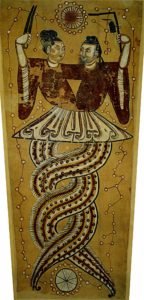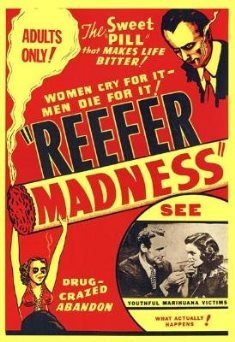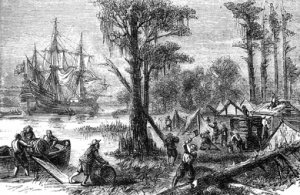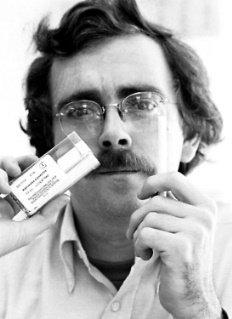To better understand the uniqueness within a CBD molecule, it is important to retrace the various uses of the original plant, Cannabis Sativa L.
For 10 000 years, our ancestors depended on its extremely strong fiber, its cellulose-rich pulp and its highly nutritious seeds. Throughout the history of mankind, hemp has been used for food, for heating, for house building, and to make paper, rope and sails. Actually, It has also been used for healing. It was not until the 1930s that the United States began to demonise the plant’s properties and outlawed all use of it, with Europe following suit. We have listed below some key dates throughout the history of cannabis.
Chinese emperor Fu Hsi references marijuana as a popular medicine
Chinese emperor Fu Hsi makes reference to Ma, the Chinese word for cannabis, due to being a very popular medicine that possessed both yin and yang.

Emperor Fu Hsi
Source: jaars.org
The Shennong Bencao Jing mentions several usage applications of the plant
The famous pharmacological treatise on traditional Chinese medicine refers to the plant effects on combating rheumatic pain, gout, absent-mindedness, menstrual pains, malaria and beriberi.
Egyptians use cannabis for glaucoma, inflammation, and painful secretions
Prescriptions for cannabis in ancient Egypt included treatment for glaucoma, inflammation and pains in the uterus, as well as for administering enemas.
The Book of Exodus describes the preparation of the holy anointing oil with cannabis as an ingredient.
Holy anointing oil, as described in the original Hebrew version of the recipe in Exodus (30: 22-23), contained over 2 liters of kaneh-bosem, a substance identified by respected etymologists, linguists, anthropologists, botanists and other researchers as cannabis. It was extracted and mixed with olive oil and other herbs.
The “Bhang” used in India as an anesthetic
This cannabis-and milk-based drink, was used as an anesthetic and anti-phlegmatic in India. In fact, this plant began to be used in this region to cure a wide variety of human diseases.
Medical use of cannabis in the Middle East
The Avesta holy text, the ancient Persian religious text purportedly written by the founder of Zoroastrianism, mentions hashish as the most important plant of the 10,000 medicinal plants mentioned.
Persian prophet and philosopher Zoroaster
Source: jaars.org
Treatise of Sushruta Samhita: cannabis as a cure for leprosy
Cannabis is more and more used in India for medical applications. People believed it could quicken the mind, prolong life, improve judgment, lower fevers, induce sleep and cure dysentery… The first major accomplishment to lay out the uses of cannabis was the treatise of Sushruta Samhita.
Medicinal cannabis used in Ancient Greece
In ancient Greece, cannabis was used as a remedy for earache, edema and inflammation.
Romans alleviate earaches with cannabis
Pedanius Dioscorides, a Greek physician of the Roman army who studied many plants and gathered his knowledge into a book entitled De Materia Medica, mentions the plant as a treatment for earache.
De Materia Medica
Source: herb.co
Cannabis in the Arabic world
Cannabis was used medicinally across the Arabic world during Roman times, more specificially, it was applied to a wide variety of ailments (from migraines to syphilis) and as an analgesic and anaesthetic.
Cannabis used commonly during the Middle Ages
During the Middle Ages, hemp was central inside any herbalist’s medicine cabinet. William Turner, the naturalist considered as the first English botanist, vaunts the benefits of cannabis in his book, New Herball.
Treatment for vomiting, parasitic infections and haemorrhage in China
The Bencao Gangmu Materia Medica text by Li Shizhen describes the use of cannabis to treat vomiting, parasitic infections, and haemorrhages. It continues to be used in China as a popular remedy for diarrhoea and dysentery and to stimulate appetite.
Exportation to North America
The Jamestown Settlers exported the plant, commonly known as hemp, to North America. Throughout the colonial period, hemp fiber was essential for its various industrial purposes. Virginia awarded bounties for hemp culture and manufacture, and imposed penalties on those who did not produce it.
Illustration of the Jamestown colony
Source: ushistormimages.com
Popular English mental health book recommends cannabis to treat depression
The Oxford scholar Robert Burton suggests cannabis as a treatment for depression in his book “The Anatomy of Melancholy”.
George Washington grows hemp
Washington’s diary entries indicate that he grew hemp at Mount Vernon for about 30 years. According to his agricultural ledgers, he had a particular interest in the medicinal use of cannabis.
Page from George Washington’s diary dated August 1765
Source: Library of Congress
Napoleon’s forces bring cannabis from Egypt to France
Napoleon invaded Egypt with forces which include a scientific expedition team. In addition to the discovery of the Rosetta Stone, the team brings cannabis back to France in 1799. Cannabis begins to be studied in Europe for its pain relieving and sedative effects, and little by little, it became more widely accepted in Western medicine.
Queen Victoria uses cannabis for menstrual cramps
En la época victoriana, esta planta se usaba con asiduidad para los espasmos musculares, los calambres menstruales, los reumatismos, las convulsiones del tétanos, la rabia y la epilepsia. Así mismo, se ha utilizado para favorecer las contracciones uterinas durante el parto y como sedante para inducir el sueño. La Reina Victoria lo usaba contra los dolores menstruales.
Reina Victoria
Fuente: gutenberg.org
Cannabis added to US pharmacopoeia
The United States Pharmacopeia (an official public standards-setting authority for all prescription and over-the-counter medicines), listed cannabis as treatment for numerous afflictions, including: neuralgia, tetanus, typhus, cholera, rabies, dysentery, alcoholism, opiate addiction, anthrax, leprosy, incontinence, gout, convulsive disorders, tonsillitis, insanity, excessive menstrual bleeding and uterine bleeding, among others.
A cannabis-based prescription drug
Source: antiquecannabisbook.com
The decline
In the 20th century, recreational use of cannabis was brought into disrepute. This, along with the on-going development of synthetic drugs such as aspirin, chloral hydrate, bromide, barbiturates and opium derivatives contributed to its declining medicinal purpose.
During the 30s, a hysterical anti-cannabis movement flourished. Newspapers attempted to outdo one another with increasingly overbearing and sensational revelations, stating that cannabis use led to madness and murder. Harry J. Anslinger, the first Commissioner of the US Federal Bureau of Narcotics, was on the hunt for a new restriction to pursue, following the end of alcohol prohibition. Others suspected conspiracy from several large companies, as hemp was used in a wide range of fields such as medicine, construction, textiles, sailing, etc. Some even thought it could be used as a fuel in an automobile project. Cannabis consumption became illegal in America and Europe.
However, one report, published by a scientific committee set up by the mayor of New York in 1938, established that smoking cannabis did not lead to addiction in the medical sense of the word; adding that it could not be used as a determining factor in committing a crime and that advertising campaigns demonizing the effects of this plant were unfounded.

Poster of a film, sponsored by an American church, which portrays people who commit a series of criminal acts as murder and rape after consuming cannabis
Discovery of CBD and THC inside the plant
In 1964, Dr. Raphael Mechoulam, Professor of Medicinal Chemistry at the Hebrew University of Jerusalem, was the first to identify THC (delta-9-tetrahydrocannabinol) and CBD (cannabidiol), two most prominent cannabinoids present in the Cannabis Sativa L. plant.
UK´s Wootton Report finds cannabis is less dangerous than alcohol and other drugs
Written by the UK government’s Advisory Committee on Drug Dependence, this report found that “the long term consumption of cannabis in moderate doses has no harmful effects… Cannabis is less dangerous than the opiates, amphetamines and barbiturates, and also less dangerous than alcohol… “
The report influenced future drug policies by reducing, for example, penalities for possession of cannabis.
Discovery of CBD as an anxiolytic
Researchers discovered that CBD acts as an anxiolytic, reducing or even blocking convulsions caused by epilepsy.
During the 70s, clinical studies demonstrated that consuming the compound, soothes down the nausea and vomiting caused by chemotherapy. The sedative effects of the chemical compound were also discovered around this time. After having confirmed the phenomenon in animals, various studies demonstrated that it improves sleeping in patients suffering insomnia.
U.S.Federal Court Ruling: Robert Randall’s Use of cannabis is a “Medical Necessity”
Robert Randall was taken to court for growing cannabis plants. Federal judge James Washington deemed Randall’s usage of the plant constituted a “medical necessity”.
Randall was the first American to receive cannabis in order to treat a medical disorder.
Robert Randall
Source: denverpost.com
New Mexico passes first state law recognizing the medical value of the plant
New Mexico passed the first state law recognizing the medical value of cannabis. Over the next few years, more than 30 states passed a similar legislation.
CBD in the treatment of psychosis
In 1982, the first scientific proof appeared highlighting the antipsychotic effects of CBD. Experiments proved that this compound inhibits symptoms such as altered perception, depersonalization and a refusal to communicate with others.
Scientists discover cannabinoid receptors
Scientists detected, for the very first time, a system of cannabinoid receptors established in the human nervous system. As a consequence, this discovery paved the way for new trials, within different medical fields, which were published over the following decade.
Cannabinoid receptors in the human brain.
Source: HowStuffWorks.com, 2001
Scientists discover the first endocannabinoid
Dr. Mechoulam, along with Dr. William Devane and Dr. Lumir Hanus, identified the brain’s first endogenous cannabinoid (or endocannabinoid).In fact, they discovered “Anandamide” from the Sanskrit word “ananda”, which means “eternal bliss” or “supreme joy”, it is the brain’s natural version of THC. The feeling of euphoric well-being perceived after jogging, for example, (which releases anandamide) is due to endocannabinoids. The Endocannabinoid System in the brain is also believed to help mediate emotions, consolidate memory and coordinate movement.
California becomes USA´s first state to legalize medical marijuana
Proposition 215, as it is known, permitted patients, with a physician’s recommendation, to possess and cultivate cannabis for the treatment of AIDS, cancer, muscular spasticity, migraines, and several other disorders.
Medical marijuana activist Chris Conrad and his wife Mikki Norris advocated for the passage of Prop. 215
Source: chrisconrad.com
Discovery of the antioxidant and neuroprotective properties of CBD.
A group of researchers at the US National Institute of Mental Health revealed that CBD is a powerful cellular antioxidant. Later studies indicated that CBD has also neuroprotective properties. Therefore, this chemical compound from cannabis could be useful in reducing neuron degeneration, caused by diseases such as Alzheimer’s or Parkinson’s.
The role of CBD in autoimmune diseases
Various other studies surrounding the medicinal potential of CBD were carried out, broadly following two different lines of investigation: its effect on cells in the immune system, as well as, its anti-inflammatory and calming properties. These studies suggested that the compound may halt the advance of rheumatoid arthritis. Besides that, it is capable of regulating the presence of certain molecules, involved in the development of tumors, through its immunosuppressive and anti-inflammatory action. Addionally, they demonstrated the efficacy of CBD-based treatment in relieving chronic neurological pain.
Later on, studies displayed that CBD could be used to treat diseases such as epilepsy, anxiety, schizophrenia, cardiovascular diseases and cancer.
L’ EIHA demands reasonable regulation about CBD in Europe
The European Industrial Hemp Association calls for reasonable regulation of CBD in food, cosmetics, herbal medicine and as a medicinal product:
“CBD has a wide range of beneficial physiological effects and a favorable profile in terms of consumer safety. Many scientific studies demonstrate the therapeutic potential of CBD for a variety of diseases and symptoms such as anxiety disorders post-traumatic stress disorder), obesity, epilepsy, dystonia, diabetes, cancer, neuro-dermatitis and Alzheimer’s disease. Its antibacterial properties can be used to prevent infection, inflammation since CBD is effective against staphylococci, streptococci and even against clinically relevant MRSA (methicillin-resistant Staphylococcus aureus).
The pharmacological effects of CDB at lower doses are health maintenance properties (physiological effects). These include antioxidant, neuroprotective and anti-inflammatory effects. For example, CBD is a more powerful neuroprotective antioxidant than ascorbate (“Vitamin C”) or tocopherol (“Vitamin E”). As a cosmetic ingredient, CBD can be used to decrease sebum / sebocytes. “
The EIHA supports the development of a harmonized legislation in this area to enable this sector to grow but also to ensure that consumers are adequately protected.









